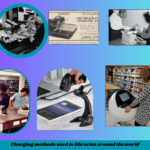Reprography, often referred to as document reproduction, encompasses the fascinating art and science of creating copies. At its core, reprography is the process of replicating documents through various photographic techniques. It can be defined as “the science of duplicating documents using photography,” and it embodies an array of advanced methods for producing precise replicas, leveraging the principles of light, heat, and radiation.
This intricate process can transform an original document into a myriad of copies by employing a range of innovative techniques. Among these are:
- Microcopies: Tiny reproductions that capture the essence of documents at a minuscule scale, allowing for efficient storage and management.
- Blueprints: These striking blueprints serve as detailed architectural plans, meticulously transferring designs onto paper.
- Electro-copies: Utilizing electrical methods to produce high-quality duplicates, ensuring fidelity to the original.
- Thermo copies: These copies harness heat to develop images, often used in specialized printing applications.
- Microfilming & Microfiche: A classic yet enduring method, these techniques preserve extensive archives in a compact format, making them easily accessible.
- Scanning: The modern marvel of digitization, where documents are converted into electronic formats, making sharing and storage remarkably simple.
- Diazo Printing: A process favored for its speed and cost-effectiveness, producing high-contrast copies that stand out with clarity.
- 3D Printing: A groundbreaking innovation that adds a new dimension to reprography, allowing for the creation of physical objects from digital models.

Through these diverse methods, reprography transforms the mundane task of copying into an intricate blend of technology and artistry, enabling the precise replication of information for various practical applications.
Reproduction processes can be broadly categorized into two distinct types:
The first type involves light scattering, elegantly harnessed through the lens of a camera. This method captures the essence of the original image, translating it into a tangible form.
The second type embraces a variety of alternative means that do not rely on a camera’s eye.
1. Camera Techniques:
This category includes methods such as Photostat processes, dynamic direct photography, the Xerox technique for document duplication, as well as microfilming and microprinting—a fascinating array of technologies that can transform visuals into replicable formats.
2. Alternative Techniques:
This group encompasses traditional methods such as printing presses, stencils, rotary machines, carbon paper, and typewriters, each offering unique ways to produce and replicate images or text.
Delving deeper into camera techniques, we find two further subdivisions: the contact method and the optical method.
In the contact method, the original material to be reproduced is placed directly in contact with the camera, allowing for an uninterrupted and faithful replication of the source.
Conversely, the optical method employs the creative use of lenses and light; here, the image of the object is projected through the camera, enabling the reproduction of intricate details with precision.
In contact methods, the medium onto which the image is printed is typically paper or a similar base film, ensuring that the fidelity of the original is captured with clarity. In contrast, optical methods require the printed medium to be light-sensitive, allowing it to react and develop the projected image in all its vividness.
In both cases, the art of reproduction transforms the ordinary into the extraordinary, creating lasting impressions that bridge the gap between the original and its duplicate.
When creating a document, following six basic design principles can greatly improve its clarity, readability, and visual appeal. These principles are:
1. Balance
Balance in document design means distributing text, images, and empty space evenly to create an appealing layout. You can achieve this with symmetrical balance, which looks formal and structured, or asymmetrical balance, which feels more casual and energetic by placing elements of different sizes in a strategic way. Good balance makes the document easier to read and prevents clutter, leading to a clear and engaging result.
2. Alignment
Alignment helps make the document look neat and organized by arranging text, images, and other elements in a structured way. This careful placement improves readability and creates a sense of order, making it easier for readers to navigate the content. Proper alignment not only enhances the visual appeal but also gives the document a professional look, ensuring it is cohesive and understandable.
3. Contrast
Contrast gives your document visual interest and highlights important elements by using noticeable differences in color, font size, or style. By creating clear distinctions between different parts, contrast helps draw the reader’s attention and ensures that key points stand out. This technique makes the content more interesting and helps readers quickly understand the main messages.
4. Repetition
Repetition involves using the same fonts, color schemes, headings, and design elements throughout the document. This consistency creates a unified look that makes the document more appealing and organized. Repetition also reinforces brand identity, helping readers recognize the document’s purpose. By keeping a consistent style, you improve readability and achieve a polished design.
5. Proximity
Proximity groups related elements together, helping readers see connections between them. By keeping related text, images, or design parts close, this principle makes it easier for readers to understand the information. This arrangement reduces clutter, creating a more structured document that improves the overall experience and ensures a logical flow of information.
6. White Space (Negative Space)
White space, or negative space, refers to the empty areas around text, images, and design elements. It helps create balance and a visually pleasing layout. By avoiding overcrowding, white space boosts readability and clarity, allowing key content to stand out. This important aspect not only improves the user experience but also gives the document a clean, professional look, making it easier to navigate.
In conclusion, reprography plays a vital role in efficiently reproducing documents for a wide range of purposes, from business operations to educational needs. By applying the six design principles—balance, alignment, contrast, repetition, proximity, and white space—designers can enhance the visual appeal, clarity, and readability of reproduced documents, ensuring they are both functional and professional. Together, reprography and thoughtful design principles contribute to creating impactful, well-organized documents that effectively communicate their intended message.




I enjoy gathering utile info, this post has got me even more info! .
thanks a lot